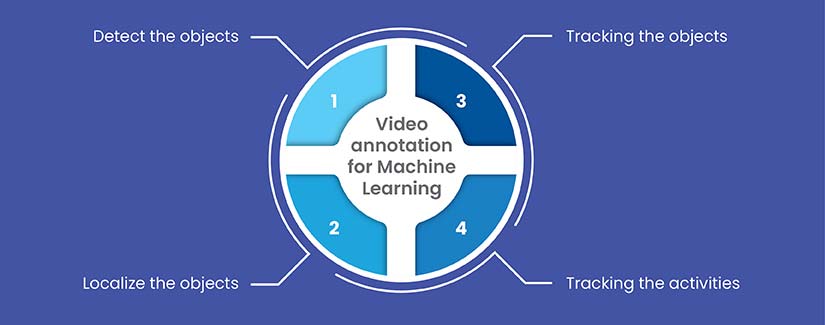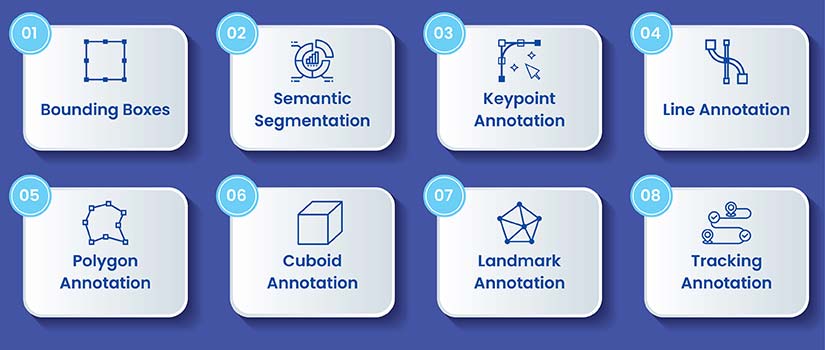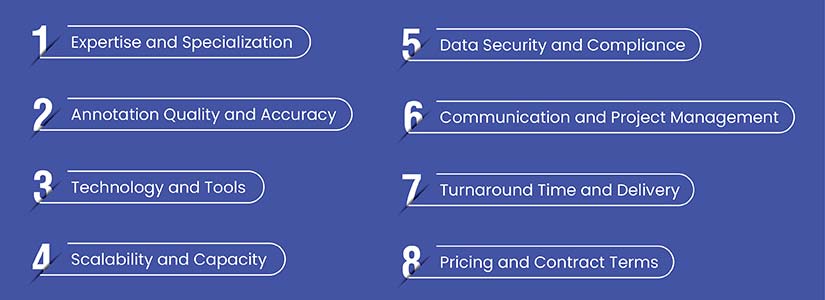- Video data’s rapid growth presents a huge opportunity for AI/ML. However, raw video lacks context, making annotations crucial for model training and understanding visual information.
- Choosing the right video annotation partner is essential for AI/ML success. This decision directly affects model performance, project outcomes, and realizing the full potential of video data.
- A well-chosen video annotation strategy is a critical investment in your AI/ML future. It empowers your initiative and unlocks the value hidden within video content.
Table of Contents
- What is video annotation
- Which are the different types of video annotation
- Understand project needs before choosing video annotation service
- 9 Key criteria for evaluating a video annotation service provider
- Common pitfalls to avoid in outsourcing video annotation
- 5 best practices for working with a video annotation service provider
- Video annotation in 2025 and beyond
- Conclusion
Video data is exploding. From security cameras to self-driving cars, it is becoming a dominant force in how we communicate and consume information. This surge in video content presents a massive opportunity for artificial intelligence (AI) and machine learning (ML). However, raw video data is meaningless to AI models without context. This is where video annotations become critical. It’s the process of adding meaningful labels and information to video frames. Annotated video datasets enable AI/ML models to understand and interpret visual data effectively.
This guide provides a framework for making informed decisions in video annotation. It covers key criteria, best practices, and potential pitfalls while outsourcing video annotation to ensure project success.
What is video annotation
At its core, video annotation is the process of adding metadata to video frames. This metadata provides context for AI and machine learning (ML) models. This annotation process provides the base material for training AI computer vision models to “see” and understand video content. The annotations can take the form of bounding boxes, polygons, keypoints, semantic segmentation, etc. to creates training data. Accurate annotated videos teach AI models to recognize objects, track movements, and even understand complex scenes.

Video annotation empowers AI to identify objects, understand actions, and analyze complex visual scenes. Without this labeled data, ML models cannot effectively learn from video content. Choosing the best video annotation service provider is therefore essential for AI and ML companies looking to leverage the power of video data in their AI/ML projects.
Which are the different types of video annotation
Video annotation comes in various forms, each tailored to specific AI/ML tasks. Understanding these different types is crucial for choosing the right service provider. Here’s an overview of common video annotation techniques:
Basic types of video annotation
Basic video annotation provides foundational labels, such as bounding boxes and keypoints. It focuses on identifying and locating objects or features within individual frames.

- Bounding Boxes: Rectangular boxes that enclose an object. Simple but effective for object detection.
- Semantic Segmentation: Labels each pixel in a frame, providing a detailed understanding of the scene. Crucial for autonomous driving.
- Keypoint Annotation: Marks specific points on an object, like joints in a human body. Used in pose estimation and action recognition.
- Line Annotation: Draws lines to represent boundaries or paths. Useful for lane detection in self-driving cars.
- Polygon Annotation: Creates precise outlines of irregular shapes. Provides more accuracy than bounding boxes.
- Cuboid Annotation: 3D boxes used to annotate objects in 3D space. Essential for robotics and augmented reality.
- Landmark Annotation: Similar to keypoints but often used for facial feature annotation or identifying specific points on objects.
- Tracking Annotation: Follows an object’s movement across frames. Essential for video analytics and surveillance.
Advanced techniques of video annotation
Advanced annotation builds upon this by adding temporal context and higher-level understanding. It involves tasks like object tracking, action recognition, and scene description, which require analyzing changes across multiple frames and inferring complex relationships.
- Pose Estimation: Identifies the posture and orientation of a person or animal. Used in sports analytics and gaming.
- Emotion Recognition: Labels the emotions expressed in a video. Used in market research and human-computer interaction.
- Object Tracking: Automatically tracks objects as they move through a video. Critical for surveillance and autonomous driving.
- Action Recognition: Identifies and classifies actions happening in a video. Used in security and sports analysis.
- Event Detection: Detects and classifies specific events within a video. Used in surveillance and traffic monitoring.
- Optical Character Recognition (OCR): Extracts text from video frames. Useful for analyzing on-screen information.
- Video Summarization: Creates a shorter version of a video by highlighting key events. Used for content preview and archiving.
- Scene Description: Provides a textual description of the video content. Used in video captioning and accessibility.
Choosing the right video annotation type depends on your AI/ML goals. Partnering a video annotation service provider with expertise in your required annotation techniques is the key to success.
Understand project needs before choosing video annotation service
Before selecting a video annotation service provider, it’s essential to define your project requirements. A clear understanding of your needs will ensure a successful partnership. Several key aspects should be carefully considered.
- Annotation Types – Different AI/ML tasks require different annotation types. Choose the annotation types that align with your project goals. This ensures the data is suitable for your AI models.
- Project Scope and Scale – Project scope significantly impacts provider selection. Consider video length, volume and complexity. Required accuracy also plays a role. Larger projects demand providers with robust scalability. Accuracy requirements influence the level of expertise needed.
- Data Sensitivity and Security – Data privacy is paramount, especially when dealing with sensitive video content. Medical and surveillance videos demand extra care due to their confidentiality. That’s why it’s crucial to choose providers with robust security protocols and compliance certifications like ISO 27001. This is especially true for processes like anomaly detection in surveillance videos, where secure handling of footage is as critical as the accuracy of the analysis.
- Budget Considerations – Video annotation service providers offer various pricing models. These can include per hour, per frame, per video pricing, etc. Balance cost with quality. Don’t sacrifice accuracy for a lower price. A clear budget helps narrow down your options.
Understanding your video annotation needs is the first step. Define annotation types, project scope and data sensitivity. Consider your budget and choose a provider that aligns with your requirements. This will set your AI/ML project up for success.
Key factors for choosing a video annotation provider

Choosing the right video annotation partner is a critical decision. A thorough evaluation process is essential. Consider these nine key criteria to make an informed choice. These factors will significantly impact the success of your AI/ML projects.
- Expertise and Specialization – Look for providers with proven experience. They should have expertise in your specific annotation needs. Consider industry verticals like medical, automotive, or retail. Ensure they understand your project’s unique requirements. Specialized expertise is crucial for accurate annotations.
- Annotation Quality and Accuracy – Annotation quality directly affects model performance. Evaluate the provider’s quality control measures. Ask about metrics like inter-annotator agreement. How do they assess and maintain accuracy? Request examples of their past work. Look for providers with a sound track record.
- Technology and Tools – Evaluate the technology stack used by the provider. Consider annotation platforms, software and AI-assisted tools. Do they use advanced software for efficiency? What tools do they use for quality control? Modern technology can significantly improve accuracy and speed.
- Scalability and Capacity – Ensure the provider can handle your current needs. They should also accommodate future growth. Can they scale their services as your project grows? Consider potential spikes in annotation volume. Scalability is essential for long-term partnerships.
- Data Security and Compliance – Data security is paramount. Verify the provider’s security protocols. Check for data encryption methods and compliance. Ensure they meet relevant regulations, such as GDPR, HIPAA and CCPA. Data privacy is a non-negotiable requirement.
- Communication and Project Management – Effective communication is key to successful collaboration. Assess the provider’s communication channels. How do they manage projects and provide updates? Look for clear reporting capabilities. Seamless communication ensures smooth project execution.
- Turnaround Time and Delivery – Timely delivery is crucial for meeting project deadlines. Discuss realistic turnaround times for various tasks. Set clear expectations for the provider. A reliable provider will deliver annotations on schedule. Timely delivery keeps projects on track.
- Pricing and Contract Terms – Carefully review pricing models and payment terms. Understand all contract details before signing. Look for transparency in pricing. Clarify any questions about payment schedules or revisions. A clear contract protects both parties.
- Client Testimonials and Case Studies – Request references from previous clients. Review case studies to gauge performance what is their track record of client satisfaction? Do they have experience with similar projects? Client feedback provides valuable insights.
Choosing the right video annotation provider requires careful consideration. Evaluate expertise, quality, technology and scalability. Prioritize data security, communication and turnaround time. Thoroughly review pricing and contract terms. Client testimonials and case studies offer valuable perspectives. By considering these nine key criteria, you can select a partner that meets your needs and contributes to the success of your AI/ML initiatives.
Common pitfalls to avoid in outsourcing video annotation
The process of choosing a video annotation provider can be complex. Several common pitfalls can derail a project. Being aware of these potential issues is crucial. Avoiding these mistakes will ensure a smooth and successful partnership.
- Hidden Costs – Be wary of hidden costs. Data transfer fees, rush charges, and revision fees can add up. Clarify all costs upfront. Get a detailed breakdown of pricing. Transparency is key to avoiding budget surprises. Don’t assume anything; ask about every potential charge.
- Communication Barriers – Communication challenges can hinder progress. This is especially true for offshore providers. Language and cultural differences can create misunderstandings. Establish clear communication channels. Consider using project management tools. Regular updates and feedback are essential.
- Data Security Risks – Data security is paramount. Protecting sensitive data is crucial. Verify the provider’s security measures. Ensure they comply with relevant regulations. GDPR, HIPAA and CCPA compliance are essential. Data encryption and access controls are non-negotiable. Don’t take data security lightly.
- Lack of Scalability – Scalability is essential for long-term projects. Choose a provider that can grow with your needs. Ensure they can handle increasing annotation volumes. A lack of scalability can cause bottlenecks. It can lead to project delays and frustration. Plan for future growth from the start.
Avoiding these common pitfalls is crucial for success. Be aware of hidden costs and communication barriers. Prioritize data security and scalability. Thorough due diligence will help you choose the right partner. A successful partnership will contribute to your AI/ML goals.
The future of video annotation
The field of video annotation is constantly evolving. Technological advancements are shaping their future. AI and machine learning play a significant role. These trends will define video annotation in 2025 and beyond.
- Advancements in AI-Assisted Annotation – AI is transforming video annotation. Automated tools are becoming more sophisticated. They assist annotators with tedious tasks. This increases efficiency while maintaining quality. AI can pre-label objects and track movements. Human annotators can then refine the results. This human-in-the-loop approach is becoming increasingly common. It combines the speed of AI with human accuracy.
- Integration with Machine Learning Pipelines – Seamless integration is a key trend. Video annotation services are becoming more integrated. They are connecting directly with machine learning workflows. This improves productivity and reduces manual steps. Data can flow directly from annotation to model training. This streamlined process accelerates AI development. It enables faster iteration and model improvement.
How will these advancements impact the selection of video annotation service provider?
These advancements will influence provider selection. AI/ML companies will seek providers with cutting-edge technology. Providers offering AI-assisted annotation and seamless integration will have a competitive edge. Scalability and flexibility will remain important. However, technological capabilities will be a primary differentiator. Providers who embrace innovation will thrive.
The future of video annotation is bright. AI-assisted tools are enhancing efficiency. Integration with ML pipelines is streamlining workflows. These advancements will make video annotation faster, more accurate, and more accessible. They will empower organizations to unlock the full potential of video data.
Conclusion
Choosing the right video annotation partner is crucial for AI/ML success. This decision directly affects model performance and project outcomes. By carefully evaluating the aspects, you can select a provider that aligns with your goals. A strong partnership will empower your AI/ML initiatives. It will enable you to unlock the full potential of video data. Invest wisely in your video annotation strategy. It is a critical investment in your AI/ML future.
Looking for top video annotation services for your project?
Improve model performance, project outcomes, and realize the full potential of your video data.






